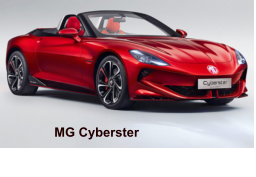

MG History
•
MG Cars got its name from Morris
Garages, which began producing
its own customised versions to the
designs of Cecil Kimber who had
joined the company as its Sales
Manager in 1921 and was
promoted to General Manager in
1922.
•
There is some question as to when
MG began. Some state it to be
1924, although the first cars bore
both Morris and MG badges and a
reference to MG with the octagon
badge appeared in an Oxford
newspaper in November 1923.
Others believe that MG only
properly began trading in 1925.
•
The first cars, which were rebodied
Morris models, used coachwork
from Carbodies of Coventry and
were built in Alfred Lane, Oxford.
•
In 1928 the company had become
large enough to separate from the
original Morris Garages and the
MG Car Company Limited was
established.
•
Space again ran out and a new
home was established in part of an
old leather factory in Abingdon,
Oxfordshire in 1929, gradually
taking over more space until
production ended there in 1980.
•
MG was absorbed into the British
Motor Corporation. BMC merged
with Jaguar Cars in 1966 to form
British Motor Holdings, which in
turn merged with the Leyland
Motor Corporation in 1968 to form
the British Leyland Motor
Corporation.
•
Following partial nationalisation in
1975 BLMC became British
Leyland. The Abingdon factory was shut down as part of the programme
of cutbacks necessary to turn BL around after the difficult times of the
1970s. Though many plants were closed, none created such an uproar
among workers, dealers, clubs and customers as this closure did.
•
After BL became the Rover Group in 1986, ownership of the MG marque
passed to British Aerospace in 1988 and then in 1994 to BMW. BMW sold
the business in 2000 and the MG marque passed to the MG Rover Group
based in Longbridge, Birmingham. The Group went into receivership in
2005 and car production was suspended on 7 April 2005.
•
In July 2005, the Nanjing Automobile Group purchased the rights to the
MG brand and the assets of the MG Rover Group for £53 million creating
a new company NAC MG UK Limited. Nanjing restarted production of the
MG TF and ZT ranges in early 2007. The TF and the ZT (renamed the
MG 7) are assembled in Pukou, Jiangsu Province in China. The MG 3, a
rebadged Rover Streetwise, also entered production at Pukou.
•
In 2006 Nanjing announced the development of a TF sports coupé.
•
In 2007, merged with Shanghai Automotive Industry Corporation.
•
The MG range was relaunched in the United Kingdom during 2008, with
an updated limited edition of the TF built at Longbridge by NAC MG UK,
called the TF LE500. Production of the TF at Longbridge was suspended
again in October 2009.
•
In January 2009, NAC MG UK was renamed MG Motor UK Limited.
•
The MG 6 hatchback variant of the Roewe 550 was announced in April
2009. It is expected that this model will be assembled both in China,
starting in 2010, and at Longbridge, in 2011.
Car models
•
The earliest model, the 1924 MG 14/28 consisted of a new sporting body
on a Morris Oxford chassis. The first car which can be described as a
new MG, rather than a modified Morris was the MG 18/80 of 1928 which
had a purpose designed chassis and the first appearance of the
traditional vertical MG grille. A smaller car was launched in 1929 with the
first of a long line of Midgets starting with the M-Type based on a 1928
Morris Minor chassis. Beginning before and continuing after World War II,
MG produced a line of cars known as the T-Series Midgets. These
included the MG TC, MG TD, and MG TF, all of which were based on the
pre-war MG TB.
•
MG departed from its earlier line of Y-Type saloons and pre-war designs
and released the MGA in 1955.
•
The MGB was released in 1962 to satisfy demand for a more modern and
comfortable sports car and continued in production until 1980.
•
In 1965 this was followed by the MGB GT.
•
Between 1967 and 1969 a short-lived model called the MGC was
released. The MGC was based on the MGB body, but with a larger six-
cylinder engine.
•
MG began producing the MG Midget in 1961. The Midget was a re-
badged and slightly restyled second-generation Austin-Healey Sprite.
•
The 1974 MGB was the last model made with chrome bumpers due to
new United States safety regulations and now had thick black rubber
bumpers.
•
As with the MGB, the Midget design was frequently modified until 1980
when the last of the range was made.
•
The MG badge lived on after 1980 under BL, being used on a number of
Austin saloons including the Metro, Maestro, and Montego.
•
The Rover Group revived the two-seater with the MG RV8 in 1992.
•
The all-new MGF went on sale in 1995, becoming the first mass-
produced "real" MG sports car since the MGB ceased production in 1980.
•
The MG range was expanded in the summer of 2001 with the introduction
of three Rover-based sports models. The MG ZR was based on the
Rover 25, the MG ZS on the Rover 45, and the MG ZT/ZT-T on the Rover
75.
•
In 2011 MG launched the MG6 and MG6 Magnette.
•
In 2013 MG launched the MG3
•
Concept cars include the MG5 and the Icon
•
The current MG line-up consists of the 2016 launched GS, which was
MG’s first Sports Utility Vehicle, and the larger ZS SUV range introduced
in 2017 originally badged as the XS. A new MG3 super mini arrived on the
scene in 2018 and with electric cars very much in the news, we now have
the MG ZS EV SUV and MG4 EV.
•
MG Cyberster, all-new electric sports car with revolutionary design,
combining the iconic roadster heritage with modern brand design
language. Poised to open a compelling new chapter in the MG story,
expected on sale in Europe in 2024.

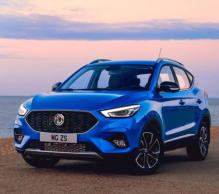
MG ZS EV
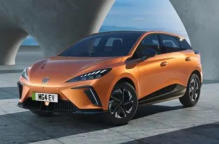
MG4 EV
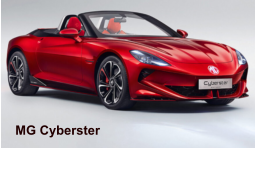



MG History
•
MG Cars got its name from Morris Garages, which
began producing its own customised versions to the
designs of Cecil Kimber who had joined the company
as its Sales Manager in 1921 and was promoted to
General Manager in 1922.
•
There is some question as to when MG began. Some
state it to be 1924, although the first cars bore both
Morris and MG badges and a reference to MG with
the octagon badge appeared in an Oxford newspaper
in November 1923. Others believe that MG only
properly began trading in 1925.
•
The first cars, which were rebodied Morris models,
used coachwork from Carbodies of Coventry and
were built in Alfred Lane, Oxford.
•
In 1928 the company had become large enough to
separate from the original Morris Garages and the
MG Car Company Limited was established.
•
Space again ran out and a new home was
established in part of an old leather factory in
Abingdon, Oxfordshire in 1929, gradually taking over
more space until production ended there in 1980.
•
MG was absorbed into the British Motor Corporation.
BMC merged with Jaguar Cars in 1966 to form British
Motor Holdings, which in turn merged with the
Leyland Motor Corporation in 1968 to form the British
Leyland Motor Corporation.
•
Following partial nationalisation in 1975 BLMC
became British Leyland. The Abingdon factory was
shut down as part of the programme of cutbacks
necessary to turn BL around after the difficult times of
the 1970s. Though many plants were closed, none
created such an uproar among workers, dealers,
clubs and customers as this closure did.
•
After BL became the Rover Group in 1986, ownership
of the MG marque passed to British Aerospace in
1988 and then in 1994 to BMW. BMW sold the
business in 2000 and the MG marque passed to the
MG Rover Group based in Longbridge, Birmingham.
The Group went into receivership in 2005 and car
production was suspended on 7 April 2005.
•
In July 2005, the Nanjing Automobile Group
purchased the rights to the MG brand and the assets
of the MG Rover Group for £53 million creating a new
company NAC MG UK Limited. Nanjing restarted
production of the MG TF and ZT ranges in early
2007. The TF and the ZT (renamed the MG 7) are
assembled in Pukou, Jiangsu Province in China. The
MG 3, a rebadged Rover Streetwise, also entered
production at Pukou.
•
In 2006 Nanjing announced the development of a TF
sports coupé.
•
In 2007, merged with Shanghai Automotive Industry
Corporation.
•
The MG range was relaunched in the United
Kingdom during 2008,
with an updated limited
edition of the TF built at
Longbridge by NAC MG
UK, called the TF LE500.
Production of the TF at
Longbridge was
suspended again in
October 2009.
•
In January 2009, NAC
MG UK was renamed MG
Motor UK Limited.
•
The MG 6 hatchback
variant of the Roewe 550
was announced in April
2009. It is expected that
this model will be
assembled both in China,
starting in 2010, and at
Longbridge, in 2011.
Car models
•
The earliest model, the
1924 MG 14/28 consisted
of a new sporting body on
a Morris Oxford chassis.
The first car which can be
described as a new MG,
rather than a modified
Morris was the MG 18/80
of 1928 which had a
purpose designed chassis
and the first appearance
of the traditional vertical
MG grille. A smaller car
was launched in 1929
with the first of a long line
of Midgets starting with
the M-Type based on a
1928 Morris Minor
chassis. Beginning before
and continuing after World
War II, MG produced a
line of cars known as the
T-Series Midgets. These
included the MG TC, MG
TD, and MG TF, all of
which were based on the
pre-war MG TB.
•
MG departed from its
earlier line of Y-Type
saloons and pre-war
designs and released the
MGA in 1955.
•
The MGB was released in
1962 to satisfy demand
for a more modern and
comfortable sports car
and continued in
production until 1980.
•
In 1965 this was followed
by the MGB GT.
•
Between 1967 and 1969 a
short-lived model called
the MGC was released.
The MGC was based on
the MGB body, but with a
larger six-cylinder engine.
•
MG began producing the
MG Midget in 1961. The
Midget was a re-badged
and slightly restyled
second-generation Austin-
Healey Sprite.
•
The 1974 MGB was the
last model made with
chrome bumpers due to
new United States safety
regulations and now had
thick black rubber
bumpers.
•
As with the MGB, the
Midget design was
frequently modified until
1980 when the last of the
range was made.
•
The MG badge lived on
after 1980 under BL,
being used on a number
of Austin saloons
including the Metro,
Maestro, and Montego.
•
The Rover Group revived
the two-seater with the
MG RV8 in 1992.
•
The all-new MGF went on
sale in 1995, becoming
the first mass-produced
"real" MG sports car since
the MGB ceased
production in 1980.
•
The MG range was
expanded in the summer
of 2001 with the
introduction of three
Rover-based sports
models. The MG ZR was
based on the Rover 25,
the MG ZS on the Rover
45, and the MG ZT/ZT-T
on the Rover 75.
•
In 2011 MG launched the
MG6 and MG6 Magnette.
•
In 2013 MG launched the
MG3
•
Concept cars include the
MG5 and the Icon
•
The current MG line-up
consists of the 2016
launched GS, which was
MG’s first Sports Utility
Vehicle, and the larger ZS
SUV range introduced in
2017 originally badged as
the XS. A new MG3 super
mini arrived on the scene
in 2018 and with electric
cars very much in the
news, we now have the
MG ZS EV SUV and MG4
EV.
•
MG Cyberster, all-new
electric sports car with
revolutionary design,
combining the iconic
roadster heritage with
modern brand design
language. Poised to open
a compelling new chapter
in the MG story, expected
on sale in Europe in 2024.

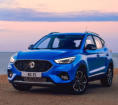
MG ZS EV

MG4 EV




MG History

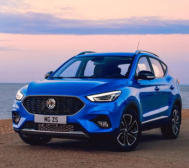
MG ZS EV

MG4 EV
•
MG Cars got its name from Morris Garages,
which began producing its own customised
versions to the designs of Cecil Kimber who
had joined the company as its Sales Manager
in 1921 and was promoted to General
Manager in 1922.
•
There is some question as to when MG
began. Some state it to be 1924, although the
first cars bore both Morris and MG badges and
a reference to MG with the octagon badge
appeared in an Oxford newspaper in
November 1923. Others believe that MG only
properly began trading in 1925.
•
The first cars, which were rebodied Morris
models, used coachwork from Carbodies of
Coventry and were built in Alfred Lane,
Oxford.
•
In 1928 the company had become large
enough to separate from the original Morris
Garages and the MG Car Company Limited
was established.
•
Space again ran out and a new home was
established in part of an old leather factory in
Abingdon, Oxfordshire in 1929, gradually
taking over more space until production ended
there in 1980.
•
MG was absorbed into the British Motor
Corporation. BMC merged with Jaguar Cars in
1966 to form British Motor Holdings, which in
turn merged with the Leyland Motor
Corporation in 1968 to form the British Leyland
Motor Corporation.
•
Following partial nationalisation in 1975 BLMC
became British Leyland. The Abingdon factory
was shut down as part of the programme of
cutbacks necessary to turn BL around after the
difficult times of the 1970s. Though many
plants were closed, none created such an
uproar among workers, dealers, clubs and
customers as this closure did.
•
After BL became the Rover Group in 1986,
ownership of the MG marque passed to British
Aerospace in 1988 and then in 1994 to BMW.
BMW sold the business in 2000 and the MG
marque passed to the MG Rover Group based
in Longbridge, Birmingham. The Group went
into receivership in 2005 and car production
was suspended on 7 April 2005.
•
In July 2005, the Nanjing Automobile Group
purchased the rights to the MG brand and the
assets of the MG Rover Group for £53 million
creating a new company NAC MG UK Limited.
Nanjing restarted production of the MG TF and
ZT ranges in early 2007. The TF and the ZT
(renamed the MG 7) are assembled in Pukou,
Jiangsu Province in China. The MG 3, a
rebadged Rover Streetwise, also entered
production at Pukou.
•
In 2006 Nanjing announced the development
of a TF sports coupé.
•
In 2007, merged with Shanghai Automotive
Industry Corporation.
•
The MG range was relaunched in the United
Kingdom during 2008, with an updated limited
edition of the TF built at Longbridge by NAC
MG UK, called the TF LE500. Production of
the TF at Longbridge was suspended again in
October 2009.
•
In January 2009, NAC MG UK was renamed
MG Motor UK Limited.
•
The MG 6 hatchback variant of the Roewe 550
was announced in April 2009. It is expected
that this model will be assembled both in
China, starting in 2010, and at Longbridge, in
2011.
Car models
•
The earliest model, the 1924 MG 14/28
consisted of a new sporting body on a Morris
Oxford chassis. The first car which can be
described as a new MG, rather than a
modified Morris was the MG 18/80 of 1928
which had a purpose designed chassis and
the first appearance of the traditional vertical
MG grille. A smaller car was launched in 1929
with the first of a long line of Midgets starting
with the M-Type based on a 1928 Morris Minor
chassis. Beginning before and continuing after
World War II, MG produced a line of cars
known as the T-Series Midgets. These
included the MG TC, MG TD, and MG TF, all
of which were based on the pre-war MG TB.
•
MG departed from its earlier line of Y-Type
saloons and pre-war designs and released the
MGA in 1955.
•
The MGB was released in 1962 to satisfy
demand for a more modern and comfortable
sports car and continued in production until
1980.
•
In 1965 this was followed by the MGB GT.
•
Between 1967 and 1969 a short-lived model
called the MGC was released. The MGC was
based on the MGB body, but with a larger six-
cylinder engine.
•
MG began producing the MG Midget in 1961.
The Midget was a re-badged and slightly
restyled second-generation Austin-Healey
Sprite.
•
The 1974 MGB was the last model made with
chrome bumpers due to new United States
safety regulations and now had thick black
rubber bumpers.
•
As with the MGB, the Midget design was
frequently modified until 1980 when the last of
the range was made.
•
The MG badge lived on after 1980 under BL,
being used on a number of Austin saloons
including the Metro, Maestro, and Montego.
•
The Rover Group revived the two-seater with
the MG RV8 in 1992.
•
The all-new MGF went on sale in 1995,
becoming the first mass-produced "real" MG
sports car since the MGB ceased production
in 1980.
•
The MG range was expanded in the summer
of 2001 with the introduction of three Rover-
based sports models. The MG ZR was based
on the Rover 25, the MG ZS on the Rover 45,
and the MG ZT/ZT-T on the Rover 75.
•
In 2011 MG launched the MG6 and MG6
Magnette.
•
In 2013 MG launched the MG3
•
Concept cars include the MG5 and the Icon
•
The current MG line-up consists of the 2016
launched GS, which was MG’s first Sports
Utility Vehicle, and the larger ZS SUV range
introduced in 2017 originally badged as the
XS. A new MG3 super mini arrived on the
scene in 2018 and with electric cars very
much in the news, we now have the MG ZS
EV SUV and MG4 EV.
•
MG Cyberster, all-new electric sports car with
revolutionary design, combining the iconic
roadster heritage with modern brand design
language. Poised to open a compelling new
chapter in the MG story, expected on sale in
Europe in 2024.
